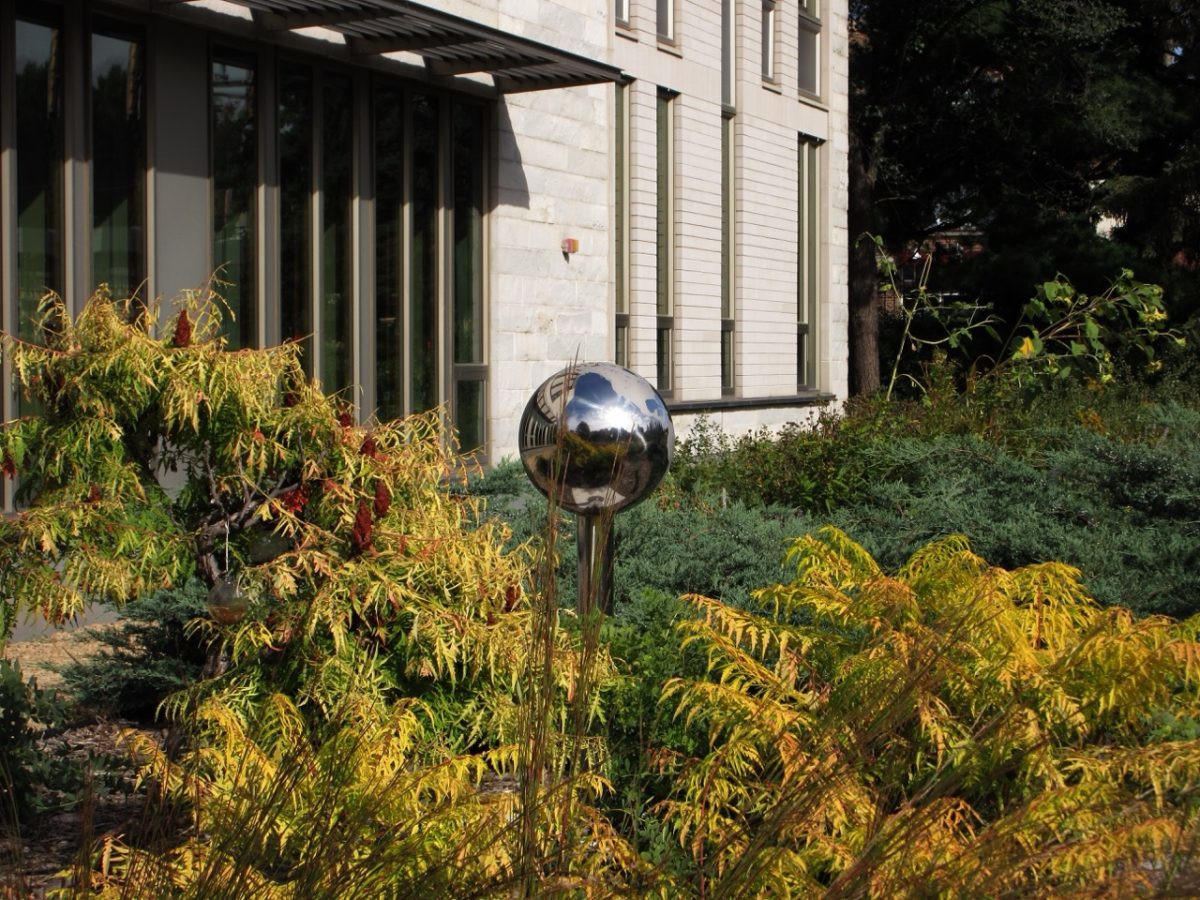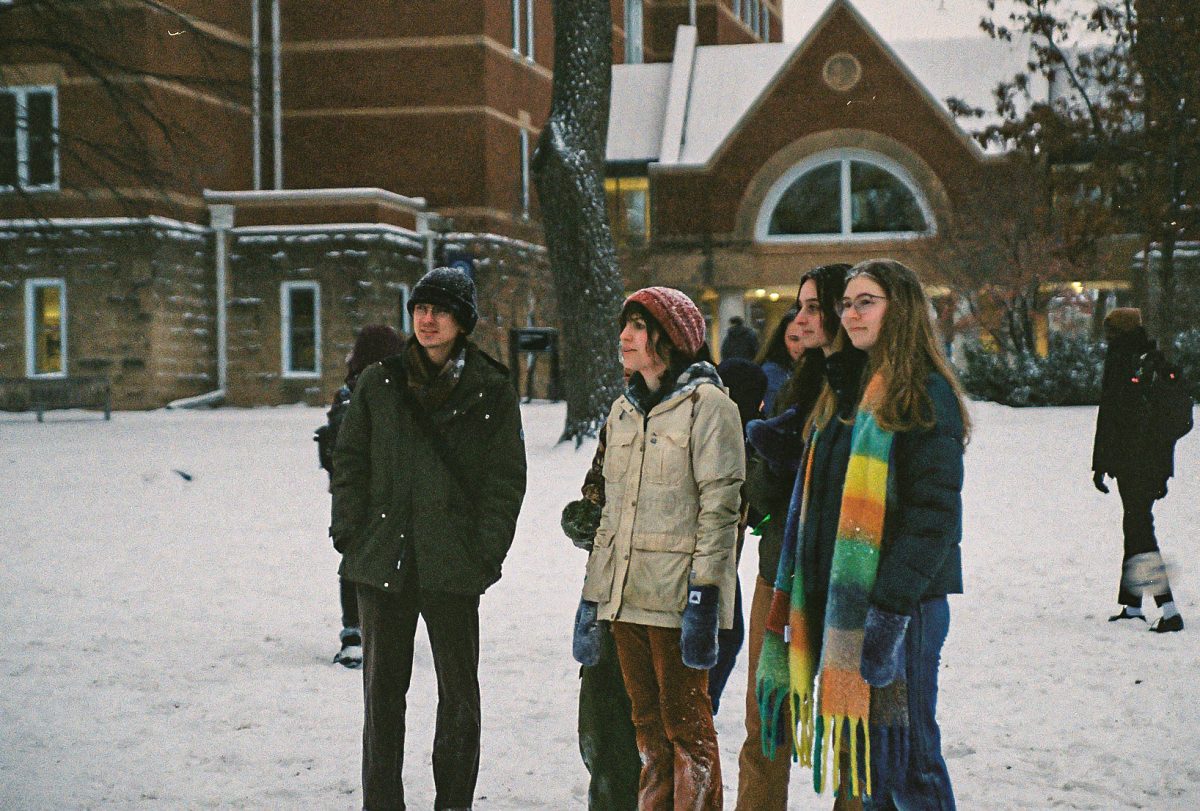Some students returning to Macalester will note how beautifully green the campus appears after their long summer absences. The flowerbeds around the flagpole have been planted with dahlias, petunias and wax begonias — each in full-bloom. The campus center (CC) is fringed with black-eyed susans and native grasses which are just now wilting with the oncoming fall. Each garden that grows in every corner of campus is a system which is constantly changing, but it doesn’t change without help.
The grounds take shape because of the work from grounds crew, student workers and many collaborative organizations. Their work has been extensive, and the result has been a myriad of new changes.
At the helm of this work is Lead Groundsperson Mike Frazier. His office is out of the way of most Mac students’ paths, on the lower floor of Janet Wallace Fine Arts Center. It is an expansive place filled with racks of weed wackers and shovels from which Frazier coordinates the frantic projects that keep the grounds in season year after year.
Frazier said that this summer was especially busy. Alongside standard upkeep like regular mowing and weeding, a number of larger projects have presented themselves. Several ash trees on Vernon Street have been the catalyst for one of the summer’s biggest undertakings. “[The City of St. Paul] took out a bunch of ash trees that had [an] emerald ash borer,” Frazier said. “They replaced those trees, and then they died. So we got [a permit from the city] and did it ourselves.”
Alongside the removal, new beds have been planted and are swiftly taking root. Over the summer and in recent weeks, the four employees who manage the grounds of the college have been sending requests for new flowers to Frazier’s desk. The new globe amaranth by the library isn’t just flashy, it keeps landscaping prices low. The number and variety of flowers on campus may seem staggering, but Frazier’s connections ensure that new seedlings are arriving as fast as they’re needed.
“We get a pretty good discount with Burpee [Seeds],” Frazier said. “A $10 perennial, we can usually get for like six bucks. We’ve got a wholesale account with them… and they give a bulk discount for companies and schools.”
Frazier purchased and planted the hundreds of chrysanthemums which now sprout around the Mac sign at the corner of Macalester Street and Grand Avenue. Directly to the north of this seasonal patch, in front of Bigelow Hall, a whole new flowerbed has appeared. Bill Steigauf, an associate groundskeeper, began the project.
“We don’t have any irrigation [on the south side of Bigelow,]” Franzier said. “We have irrigation on the boulevard, but not up by the building… It was pretty bad.”
So, Steigauf took out the sod and got the plants. Where there was once mud, there are now sprouts of yarrow, sumac and hydrangeas pushing up from newly laid mulch.
The role of groundskeeping goes far deeper than aesthetic value. Eli Suppelsa ’27 worked for grounds maintenance over the summer, keeping to a strict schedule to prepare the grounds for students’ arrival on Aug. 18.
At 6:30 a.m. every morning, he arrived on campus and began work on his projects. His specialty was maintaining the athletic fields. “One of the bigger things that I was doing over the summer was revamping …[the] summer management of the baseball fields, “ Suppelsa said. “A big thing was we would be edging the grass along the side, the grass around the baseball field and the softball field.”
Frazier was concerned about these specific grasses on the athletic fields. Pest grasses, like annual bluegrass (Poa annua), pose a risk that Suppelsa and other members of the grounds crew work to curb.
“A lot of times, if soccer is practicing out there, they’re turning a lot and [the Poa grass] pulls up,” Frazier said. “So we’d like to keep that out of there so [that athletes are] not slipping around, flipping their ankles and blowing out knees.”
Another landscape newcomer has appeared in four different locations around campus. These are the “rain gardens,” which address the constant concern of water drainage on campus. These shallow depressions are planted with deep-rooted native plants that enhance soil permeability. Rainwater runs off the surrounding lawn, collects in the rain garden and gradually soaks back into the ground. Kirk Hall has struggled with drainage issues in the past, with water often pooling over sidewalks during periods of intense rain. Larger projects have fought the same problem in the past. An old system of cement sluices and pits lined with grass protected the Theatre and Dance Building from flooding. This infrastructure is effective, but, according to Frazier, the newly added rain gardens can address the same issue with small, sunken patches of native grasses, sunflowers, milkweed and other perennials.
“[The rain gardens] will hopefully help promote stormwater benefits such as preventing runoff and flooding…[and providing] some pollinator habitat,” the Sustainability Office wrote in an email to The Mac Weekly. “We are also incorporating them into urban ecology research through collaboration with faculty and students.”
In its early stages, the rain gardens were spearheaded by funds and consultancy from the Capitol Region Watershed District. The agency funded service offered grounds crew and the Sustainability Office a grant and the resources to implement the project.
“They sent out someone from the Watershed District to work up a plan, and they drew the plan up, gave us an estimate on cost,” Frazier said. “We’d had student help with the summer… then [the] Sustainability [Office] had some volunteers that were able to come and plant for us.”
The rain gardens in their current form are still growing into their plots, and the drainage system isn’t without flaw. Many of the native grasses only form small clumps instead of growing densely together like the same grass species do outside the CC. Beyond this, the library-adjacent garden isn’t draining as well as expected.
But, despite all of these challenges, Frazier says that he isn’t worried.
“We might have to … build [the garden] up a little bit so [more water] can actually can get into the drain if it needs to,” Frazier said. “This winter [and] this summer [were] pretty wet, so I think if we get an average rainfall, [the gardens] will be okay. We’ll see how it grows in next summer and go from there.”
Whatever issue arises, the ground crew will have a solution on hand. As the campus settles into fall, maintenance concerns and new projects will continue to keep the grounds crew busy. The student body and the rest of the Macalester community can continue to enjoy the outdoors while the grounds crew pushes forward with their own long-term plans for the beautification of campus. Things are moving forward at Mac, and its grounds are no different.











